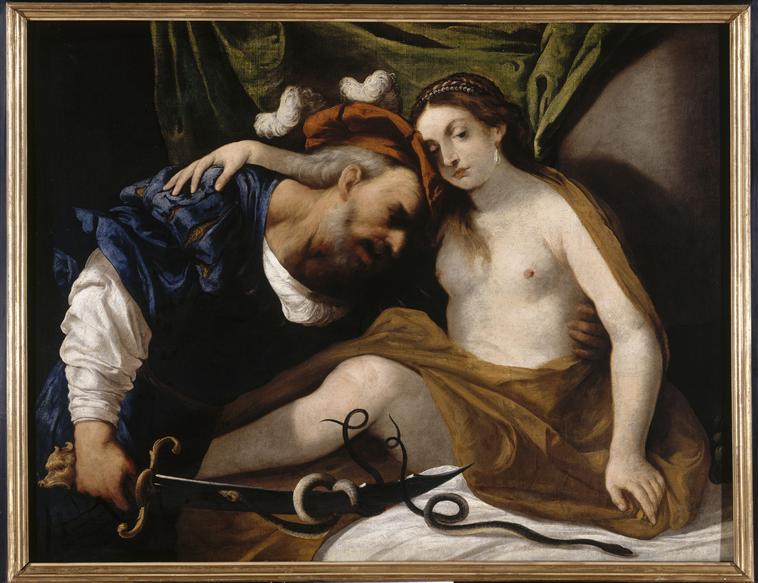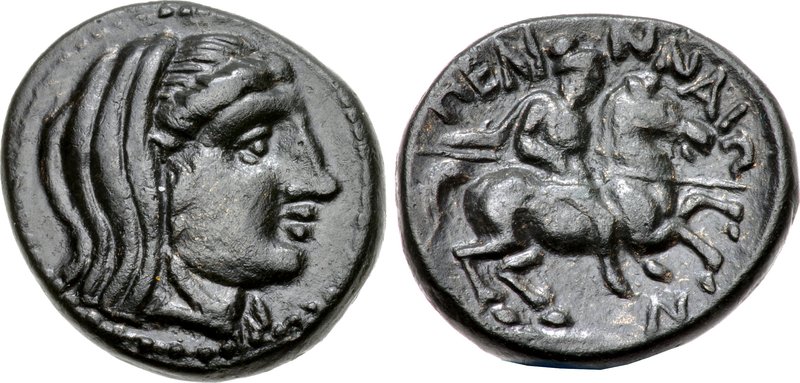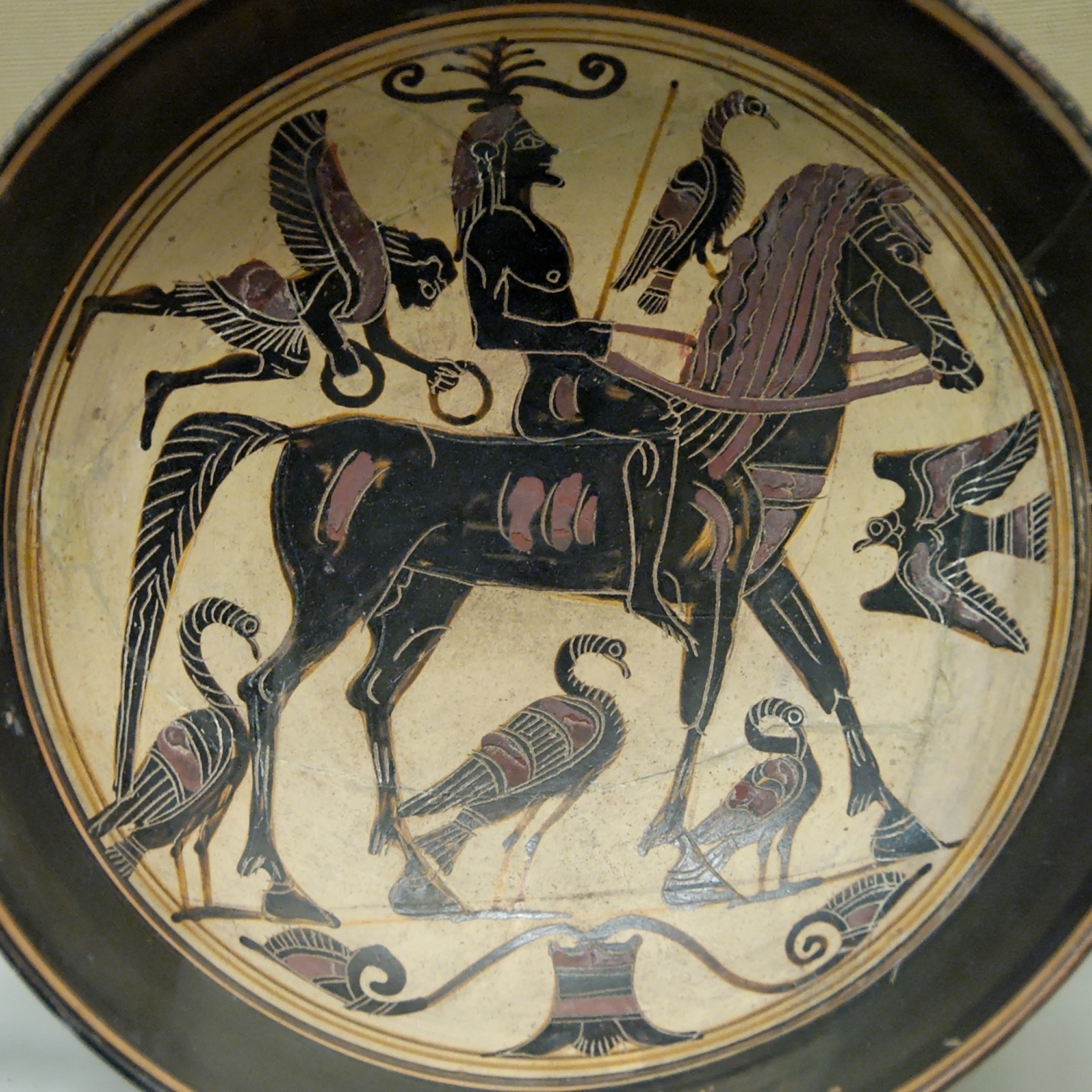|
Tiresias
In Greek mythology, Tiresias (; grc, Τειρεσίας, Teiresías) was a blind prophet of Apollo in Thebes, famous for clairvoyance and for being transformed into a woman for seven years. He was the son of the shepherd Everes and the nymph Chariclo. Tiresias participated fully in seven generations in Thebes, beginning as advisor to Cadmus himself. Mythology Eighteen allusions to mythic Tiresias, noted by Luc Brisson, fall into three groups: the first recounts Tiresias' sex-change episode and later his encounter with Zeus and Hera; the second group recounts his blinding by Athena; the third, all but lost, seems to have recounted the misadventures of Tiresias. Blindness and gift of prophecy Like other oracles, how Tiresias obtained his information varied: sometimes, he would receive visions; other times he would listen for the songs of birds, or ask for a description of visions and pictures appearing within the smoke of burnt offerings or entrails, and so interpret them ... [...More Info...] [...Related Items...] OR: [Wikipedia] [Google] [Baidu] |
Tiresias Striking The Snakes
In Greek mythology, Tiresias (; grc, Τειρεσίας, Teiresías) was a blind prophet of Apollo in Thebes, famous for clairvoyance and for being transformed into a woman for seven years. He was the son of the shepherd Everes and the nymph Chariclo. Tiresias participated fully in seven generations in Thebes, beginning as advisor to Cadmus himself. Mythology Eighteen allusions to mythic Tiresias, noted by Luc Brisson, fall into three groups: the first recounts Tiresias' sex-change episode and later his encounter with Zeus and Hera; the second group recounts his blinding by Athena; the third, all but lost, seems to have recounted the misadventures of Tiresias. Blindness and gift of prophecy Like other oracles, how Tiresias obtained his information varied: sometimes, he would receive visions; other times he would listen for the songs of birds, or ask for a description of visions and pictures appearing within the smoke of burnt offerings or entrails, and so interpret them ... [...More Info...] [...Related Items...] OR: [Wikipedia] [Google] [Baidu] |
Hera
In ancient Greek religion, Hera (; grc-gre, Ἥρα, Hḗrā; grc, Ἥρη, Hḗrē, label=none in Ionic and Homeric Greek) is the goddess of marriage, women and family, and the protector of women during childbirth. In Greek mythology, she is queen of the twelve Olympians and Mount Olympus, sister and wife of Zeus, and daughter of the Titans Cronus and Rhea. One of her defining characteristics in myth is her jealous and vengeful nature in dealing with any who offend her, especially Zeus' numerous adulterous lovers and illegitimate offspring. Her iconography usually presents her as a dignified, matronly figure, upright or enthroned, crowned with a '' polos'' or diadem, sometimes veiled as a married woman. She is the patron goddess of lawful marriage. She presides over weddings, blesses and legalises marital unions, and protects women from harm during childbirth. Her sacred animals include the cow, cuckoo and the peacock. She is sometimes shown holding a pomegranate, ... [...More Info...] [...Related Items...] OR: [Wikipedia] [Google] [Baidu] |
Chariclo
Chariclo ( or ; grc, Χαρικλώ, Khariklṓ, graceful spinner) is either of two nymphs in Greek mythology: * Chariclo, a nymph who was married the centaur Chiron and became the mother of Hippe, Endeïs, Ocyrhoe, and Carystus. In some accounts, she was described as the daughter of Apollo, Perses or Oceanus. Chariclo together with her mother-in-law Philyra the Oceanid, were the nurses of the young Achilles. * Chariclo, a nymph devotee of Athena, who became pregnant by a shepherd, Everes, giving birth to the prophet Tiresias. Tiresias was struck blind by Athena after seeing her naked. Chariclo begged Athena to give Tiresias his sight back, but the goddess could not undo her curse. She gave him the gift of prophecy instead.Apollodorus3.6.7/ref> Notes References * Pindar, ''Odes'' translated by Diane Arnson Svarlien. 1990Online version at the Perseus Digital Library.* Pindar, ''The Odes of Pindar'' including the Principal Fragments with an Introduction and an English Tr ... [...More Info...] [...Related Items...] OR: [Wikipedia] [Google] [Baidu] |
Manto (daughter Of Tiresias)
In Greek mythology, Manto (Ancient Greek: Μαντώ) was the daughter of the prophet Tiresias and mother of Mopsus. Tiresias was a Theban oracle who, according to tradition, was changed into a woman after striking a pair of copulating snakes with a rod, and was thereafter a priestess of Hera. Mythology During the War of the Epigoni, a later myth relates, Manto was brought to Delphi as a war prize. Apollo made her his priestess and sent her to Colophon to found an oracle devoted to him. She had a son named Mopsus by Apollo, although by some accounts, the father of Mopsus is Rhacius, whom Manto later married. According to the '' Bibliotheca'', she had two children by Alcmaeon, Amphilochus and Tisiphone. In an early version, Apollo instructed her to marry the first man she saw outside of Delphi (who turned out to be Rhacius). Rhacius then took her to Claros (which, like Colophon, is in western Asia Minor) and there she founded the oracle of Apollo Clarios. When she arriv ... [...More Info...] [...Related Items...] OR: [Wikipedia] [Google] [Baidu] |
Nymph
A nymph ( grc, νύμφη, nýmphē, el, script=Latn, nímfi, label= Modern Greek; , ) in ancient Greek folklore is a minor female nature deity. Different from Greek goddesses, nymphs are generally regarded as personifications of nature, are typically tied to a specific place or landform, and are usually depicted as maidens. They were not necessarily immortal, but lived much longer than human beings. They are often divided into various broad subgroups, such as the Meliae (ash tree nymphs), the Dryads (oak tree nymphs), the Naiads (freshwater nymphs), the Nereids (sea nymphs), and the Oreads (mountain nymphs). Nymphs are often featured in classic works of art, literature, mythology, and fiction. Since the Middle Ages, nymphs have been sometimes popularly associated or even confused with fairies. Etymology The Greek word has the primary meaning of "young woman; bride, young wife" but is not usually associated with deities in particular. Yet the etymology of the noun rem ... [...More Info...] [...Related Items...] OR: [Wikipedia] [Google] [Baidu] |
Auspicy
Augury is the practice from ancient Roman religion of interpreting omens from the observed behavior of birds. When the individual, known as the augur, interpreted these signs, it is referred to as "taking the auspices". "Auspices" (Latin ''auspicium'') literally means "looking at birds", and Latin ''auspex'', another word for "augur", literally means "one who looks at birds". Depending upon the birds, the auspices from the gods could be favorable or unfavorable ('' auspicious'' or ''inauspicious''). Sometimes politically motivated augurs would fabricate unfavorable auspices in order to delay certain state functions, such as elections. Pliny the Elder attributes the invention of auspicy to Tiresias the seer of Thebes, the generic model of a seer in the Greco-Roman literary culture. This type of omen reading was already a millennium old in the time of Classical Greece: in the fourteenth-century BC diplomatic correspondence preserved in Egypt called the " Amarna corresponde ... [...More Info...] [...Related Items...] OR: [Wikipedia] [Google] [Baidu] |
Mount Cyllene
Mount Kyllini or Mount Cyllene (; grc, Κυλλήνη , ; sometimes , ), is a mountain on the Peloponnese in Greece famous for its association with the god Hermes. It rises to above sea level, making it the second highest point on the peninsula. It is located near the border between the historic regions of Arcadia and Achaea—in the northeast of Arcadia, and entirely within modern Corinthia. It is located west of Corinth, northwest of Stymfalia, north of Tripoli, and south of Derveni. Several modern places are also named '' Kyllini''. Description Much of the mountain is barren and rocky, although the area below is largely forested. There is an observatory at , at 22.67 east longitude and 37.97 north latitude. From the top a large portion of northeastern Peloponnesus is visible, including the eastern part of Achaia and Chelmos, the Gulf of Corinth and most of Corinthia, the southern part of Corinthia and parts of northeastern Arcadia. The nearest mountain ranges are ... [...More Info...] [...Related Items...] OR: [Wikipedia] [Google] [Baidu] |
Apollo
Apollo, grc, Ἀπόλλωνος, Apóllōnos, label=genitive , ; , grc-dor, Ἀπέλλων, Apéllōn, ; grc, Ἀπείλων, Apeílōn, label= Arcadocypriot Greek, ; grc-aeo, Ἄπλουν, Áploun, la, Apollō, la, Apollinis, label=genitive, , ; , is one of the Olympian deities in classical Greek and Roman religion and Greek and Roman mythology. The national divinity of the Greeks, Apollo has been recognized as a god of archery, music and dance, truth and prophecy, healing and diseases, the Sun and light, poetry, and more. One of the most important and complex of the Greek gods, he is the son of Zeus and Leto, and the twin brother of Artemis, goddess of the hunt. Seen as the most beautiful god and the ideal of the ''kouros'' (ephebe, or a beardless, athletic youth), Apollo is considered to be the most Greek of all the gods. Apollo is known in Greek-influenced Etruscan mythology as ''Apulu''. As the patron deity of Delphi (''Apollo Pythios''), Apollo is an o ... [...More Info...] [...Related Items...] OR: [Wikipedia] [Google] [Baidu] |
Everes (mythology)
In Greek mythology, Everes or Eueres (Ancient Greek: Εὐήρους or Εὐήρης "well-fitted") may refer to the following characters: * Everes, the Theban father, by the nymph Chariclo, of Tiresias. He may be a descendant of Udaeus, one of the Spartoi. * Everes, an Arcadian son of Heracles and Parthenope, daughter of King Stymphalus of Arcadia. * Everes, a Taphian prince who was the only one to survive among the sons of King Pterelaus of Taphos, who was at war with Mycenae.Apollodorus2.4.5/ref> He was the brother of Chromius, Tyrannus, Antiochus, Chersidamas and Mestor. Notes References * Pseudo-Apollodorus The ''Bibliotheca'' (Ancient Greek: grc, Βιβλιοθήκη, lit=Library, translit=Bibliothēkē, label=none), also known as the ''Bibliotheca'' of Pseudo-Apollodorus, is a compendium of Greek myths and heroic legends, arranged in three book ..., ''The Library'' with an English Translation by Sir James George Frazer, F.B.A., F.R.S. in 2 Volumes, Ca ... [...More Info...] [...Related Items...] OR: [Wikipedia] [Google] [Baidu] |
Hesiod
Hesiod (; grc-gre, Ἡσίοδος ''Hēsíodos'') was an ancient Greek poet generally thought to have been active between 750 and 650 BC, around the same time as Homer. He is generally regarded by western authors as 'the first written poet in the Western tradition to regard himself as an individual persona with an active role to play in his subject.' Ancient authors credited Hesiod and Homer with establishing Greek religious customs. Modern scholars refer to him as a major source on Greek mythology, farming techniques, early economic thought, archaic Greek astronomy and ancient time-keeping. Life The dating of Hesiod's life is a contested issue in scholarly circles (''see § Dating below''). Epic narrative allowed poets like Homer no opportunity for personal revelations. However, Hesiod's extant work comprises several didactic poems in which he went out of his way to let his audience in on a few details of his life. There are three explicit references in '' Works and Da ... [...More Info...] [...Related Items...] OR: [Wikipedia] [Google] [Baidu] |
Eustathius Of Thessalonica
Eustathius of Thessalonica (or Eustathios of Thessalonike; el, Εὐστάθιος Θεσσαλονίκης; c. 1115 – 1195/6) was a Byzantine Greek scholar and Archbishop of Thessalonica. He is most noted for his contemporary account of the sack of Thessalonica by the Normans in 1185, for his orations and for his commentaries on Homer, which incorporate many remarks by much earlier researchers. He was officially canonized on June 10, 1988, and his feast day is on September 20.Great Synaxaristes: Ὁ Ἅγιος Εὐστάθιος ὁ Κατάφλωρος Ἀρχιεπίσκοπος Θεσσαλονίκης'' 20 Σεπτεμβρίου. ΜΕΓΑΣ ΣΥΝΑΞΑΡΙΣΤΗΣ. Life A pupil of Nicholas Kataphloron, Eustathius was appointed to the offices of superintendent of petitions (, ''epi ton deeseon''), professor of rhetoric (), and was ordained a deacon in Constantinople. He was ordained bishop of Myra. Around the year 1178, he was appointed to the archbishopric of Th ... [...More Info...] [...Related Items...] OR: [Wikipedia] [Google] [Baidu] |
Lost Works
A lost work is a document, literary work, or piece of multimedia produced some time in the past, of which no surviving copies are known to exist. It can only be known through reference. This term most commonly applies to works from the classical world, although it is increasingly used in relation to modern works. A work may be lost to history through the destruction of an original manuscript and all later copies. Works—or, commonly, small fragments of works—have survived by being found by archaeologists during investigations, or accidentally by anybody, such as, for example, the Nag Hammadi library scrolls. Works also survived when they were reused as bookbinding materials, quoted or included in other works, or as palimpsests, where an original document is imperfectly erased so the substrate on which it was written can be reused. The discovery, in 1822, of Cicero's ''De re publica'' was one of the first major recoveries of a lost ancient text from a palimpsest. Another fam ... [...More Info...] [...Related Items...] OR: [Wikipedia] [Google] [Baidu] |


_Pompeian_Art.jpg)




